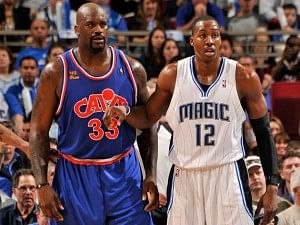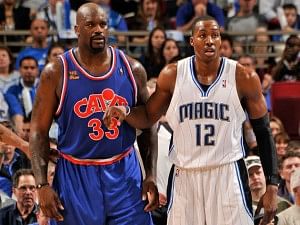
NBA Centres: Where have all the big people gone?

What’s wrong with today’s big men?
The NBA season is off and running and it has been apparent for a while that the quality of that league has been steadily deteriorating for a number of years. Back in the 80s and 90s the game was on the rise and the league was benefitting thanks to a generation of superstars led by Michael Jordan who helped the game surge in popularity and exposure. Each night you knew you were in for a highlight moment and some exhilarating action. The sport seemed to have reached its magnum opus.
But today, that is hardly the case. The game has become incredibly one dimensional, and there are periods of lulls in games that were scarcely imaginable back in the day. This decline in action can largely be reflected by plummeting TV ratings in the United States as fewer people are tuning in to watch these games. Even if they do tune into these games, the action on court, especially during the regular season is so tepid that most people just flick on to the next channel. There was a time, when such a thing was unheard of and everyone wanted a piece of the action.
So, what exactly has turned people off the product? It is happening, despite the NBA shamelessly trying to prostitute the current product as the best group of athletes to have ever been assembled on court.
But the audience has smartened itself to the marketing and realized that the current talent really is not as good as it used to be. So why exactly has this monumental change taken place? Why have games become just so monotonous and tedious to put one through?
Well, a big factor is the slow and steady waning of top quality big men in the game. The sight of a big 7 footer bossing it near the rim is something that makes fans, stand up and notice. It gets them excited. Moreover it adds a little spice and is quite frankly something different. Unfortunately, fan nowadays are missing out on this as the current crop is largely mediocre.
Of course, some people these days keep on swooning about the likes of Marc Gasol and especially Dwight Howard. That, unfortunately is a sad indication of just how thin the current talent pool is. No matter how he is packaged Howard, is just not as good as people make him out to be. He is a decent player who is unfortunately a major benefactor of playing in an era where he has inferior opposition, and when placed alongside them he seems like a world beater.
If he were placed in the talent pool of even 20 years ago, he’d get lost in the shuffle. People may scoff at such a statement, but we shall take a brief look at the numbers to further elucidate this point. Yes, numbers do not paint an absolutely accurate picture, as statistics cannot account for every nuance possible. But the following numbers shall hopefully illustrate the aforementioned points.
Let us juxtapose current talent pool with the one from the 92-93 season. In the previous season just 9 players averaged above 20 points per game. What is even more disheartening is that LaMarcus Aldridge was the only Power Forward/ Centre to feature in this list.
Conversely, twenty years prior there were 19 players, averaging over 20 points a game and what is even more telling is that in that season there were 11 players who fit into the big man category who scored over 20 points who fit into the Big Man description.
Now let us look at rebounds. In the previous season there were just 8 men who averaged more than 10 rebounds a game. You can go ahead and double that number back in 93. How can you justify such a stark contrast in numbers?
Finally last year there was just one player who averaged more than 3 blocks per game. But back then there were 5 players with the highest being 4.2 blocks per game.
If you look at the current crop and compare them to the lineup of heavy hitters back then, it tells you that basketball has really suffered in the intervening time period. Back then, you had the likes of Hakeem Olajuwon, David Robinson and the great Patrick Ewing. Even if one were to take Dikembe Mutombo and put him in today’s field, he would manage to power through most of today’s field.
To further establish this point, there were two rookies who came through in the aforesaid season: Alonzo Mourning and Shaquille O’Neal. Let us compare their rookie seasons to today’s ace player Dwight Howard’s most successful season.
Howard in the 2010-11 season, in the midst of his physical peak averaged 22.9 points per game, 14.1 rebounds per game and 2.4 blocks per game. Mourning’s rookie figures in the corresponding categories were 21 ppg, 10.3 rpg and 3.5 bpg. Now bear in mind, this is a 23 year old rookie who came and dominated and was almost as good as today’s benchmark.
But Shaq in his rookie season just blew the league away. At this point we should also point out that he had considerably more intimidating opposition facing him, yet Big Shaq averaged 23.4 ppg, 13.9rpg and 3.5 bpg.
This hopefully paints a fairly elaborate picture on how poorly the big men are faring in today’s game when this generation’s ace can barely hold up against two rookies two decades prior. As a result we have the same repetitive style of play where even these big 7 footers who are looking for 20 feet jump shots from the get go, instead of looking to start off near to the rim.
That suggests that the coaching approach itself is a major contributing factor in this decline. They are inadvertently taking away the strengths that these huge guys have. If fundamentally their instinct is to start 20 feet from the net then you know that this is what they are taught growing up. But that inherently negates their biggest attribute, their size.
Coaches need to understand that instead of trying to tame these beasts. They should looking to help them in their fundamentals to excel as powerful centres who start 4 or 5 feet from the net and then start moving out. It is quite obviously a more optimal utilization of their frame.
Numbers do not lie. The big powerful centre is a dying breed. The situation needs to be addressed because without a resurgence the NBA is condemned to perpetual mediocrity. We want the excitement and the overall anticipation back. But for that to happen it must start at the very grass roots. Hopefully in the not so distant future, this situation shall turn around. But it could very well be wishful thinking.